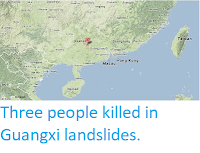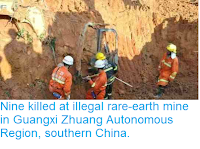The China Earthquake Networks Center recorded
a Magnitude 5.2 Earthquake at a depth of 10 km in Jingxi County in Guangxi Province, China, slightly before 9.20 am local time
(slightly before 9.20 am GMT) on Monday 25 November 2019. The Earthquake triggered a number of landslides in the area, resulting in one person being killed and four more injured, and was felt across Guangxi Province and northern Vietnam.
A landslide in the town of Hurun in Jingxi County, Guangxi, triggered by an Earthquake on 25 November 2019. Xinhau.
Earthquakes are common in west and southwest China, where the Eurasian Plate is being compressed by the impact of the Indian Plate from the south, but much less common in the east and centre of the country. However southeastern China is in fact dominated by a series of tectonic blocks, annealed onto the Eurasian Plate during the Triassic. Guangxi Province is located on the South China Block, which is being pushed to the southeast by the motion of the Tibetan Block to the northwest and North China Block to the northeast.
Tectonic map of Asia, showing relationships between the India–Asia
collision, escape of Indonesian and South China blocks seaward, and
extension from Siberia to the Pacific margin. (Note also the opening of
back-arc basins including the Sea of Japan and the South China Sea, and
extension in the Bohai Basin and eastern part of the NCC.) The North
China Craton is also strongly influenced by Pacific and palaeo-Pacific
subduction, perhaps also inducing extension in the eastern NCC. The
palaeo Pacific and Pacific subduction zones developed in the Mesozoic,
and also contributed to the hydration of the subcontinental lithospheric
mantle beneath the NCC. Kusky et al. (2007).
Witness
accounts of Earthquakes can help geologists to understand these events,
and the structures that cause them. The international non-profit
organisation Earthquake Report is interested in hearing from people who may have felt this event; if you felt this quake then you can report it to Earthquake Report here.
See also...
Follow Sciency Thoughts on Facebook.








